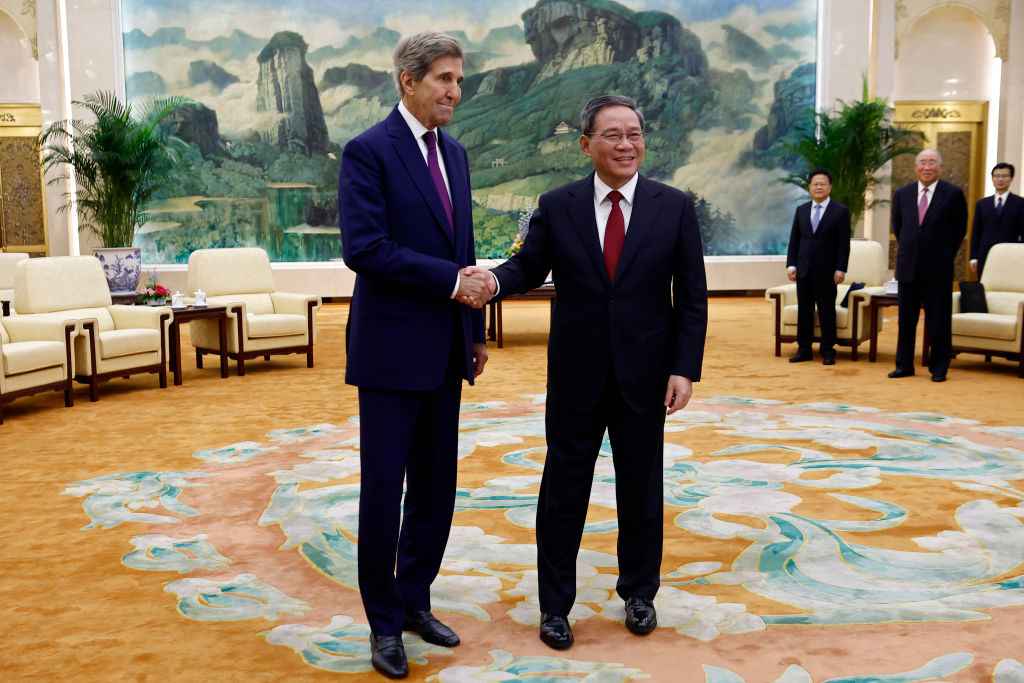
U.S. Climate Envoy John Kerry wrapped up U.S.-China climate talks in Beijing on Wednesday, the first such visit since last August, when the country iced him out after then-House Speaker Nancy Pelosi visited Taiwan, which China regards as a breakaway province. Kerry didn’t come away with much besides an agreement to keep talking, though that’s better than nothing. The U.S. and China are the world’s two largest emitters, and when the countries work together, it bodes well for getting the rest of the world on board as well. The 2015 Paris Climate Accords, for instance, were preceded by a major U.S.-China climate agreement a year earlier.
There’s a lot of serious issues, though, that stand in the way of genuine cooperation. In 2014, China’s genocide against its Uyghur minority was yet to begin in earnest, and its campaign to dismantle democratic self-governance in Hong Kong was just a twinkle in Chairman Xi’s eye. It was also before the U.S.-China trade war. Tensions around Taiwan and the South China Sea were comparatively mild, too (the U.S. was still primarily focused on extricating itself from two wars in the Middle East, rather than engaging China in geostrategic chess games).
Amid these challenges, Kerry wants the two countries to put aside their differences in making a deal to further cut emissions. “The climate crisis is a universal threat to humankind,” he said in a press conference Wednesday. “We hope that we will leave other issues aside.”
China insists that those other issues are inseparable. If the U.S. wants them to cut emissions faster, perhaps they can use that as leverage to get a concession from the U.S. somewhere else. In any case, things are still tense enough right now that China is likely loath to make any climate policy changes that look like they’re coming from U.S. pressure, so they don’t appear to lose face.
One of the biggest foundational issues though, is China’s status as a polluter. Are they a wealthy, developed nation like the U.S., which played a big role in getting us in to this thermodynamic mess? If yes, that means China has an extra large share of the responsibility to get us out of it. Or, are they a developing nation that deserves some slack, having spent the past century trying to fulfill its populations’ basic needs as the rich countries merrily burned through the world’s carbon budget?
The answer is a bit of both. China is the world’s largest overall emitter, and from that perspective one can argue that there’s no excuse for them to be holding back on cutting emissions (their net zero goal, for instance, is 2060). Instead, the country’s emissions are still going up—they’re permitting about two new coal plants a week, and have only pledged to start trending their emissions down starting in 2030.
But in some ways it might not be fair to judge them on absolute emissions alone. China, if anyone needs reminding, is huge. About 18% of the world’s population lives in the country. So while their total emissions are massive, on a per capita basis, they rank closer to the range of range of Brazil and Indonesia, and around half that of the U.S.
That’s not such a low emissions rate, though—Japan ranks similarly in per capita emissions. China also has the world’s largest middle class. All that leads to a complicated picture as to what role China should play in the world’s fight to draw down emissions. At the end of the day, though, atmospheric physics doesn’t give a hoot if carbon reductions come from China or the U.S. It’s all got to go.
A version of this story first appeared in the Climate is Everything newsletter. To sign up, click here.
More Must-Reads From TIME
- The 100 Most Influential People of 2024
- How Far Trump Would Go
- Scenes From Pro-Palestinian Encampments Across U.S. Universities
- Saving Seconds Is Better Than Hours
- Why Your Breakfast Should Start with a Vegetable
- 6 Compliments That Land Every Time
- Welcome to the Golden Age of Ryan Gosling
- Want Weekly Recs on What to Watch, Read, and More? Sign Up for Worth Your Time
Write to Alejandro de la Garza at alejandro.delagarza@time.com